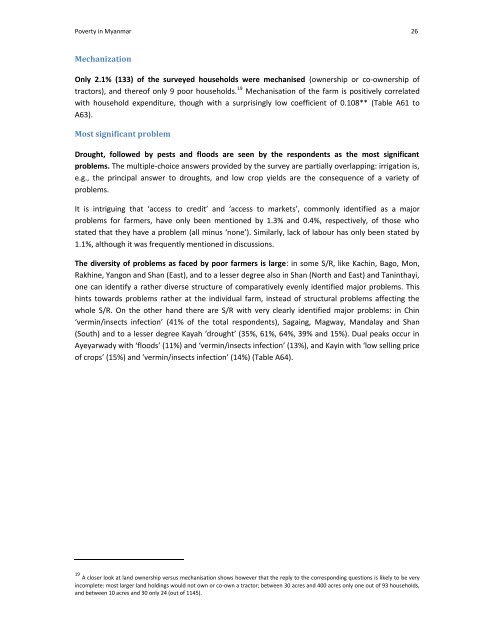A regional perspective on poverty in Myanmar - United Nations ...
A regional perspective on poverty in Myanmar - United Nations ...
A regional perspective on poverty in Myanmar - United Nations ...
You also want an ePaper? Increase the reach of your titles
YUMPU automatically turns print PDFs into web optimized ePapers that Google loves.
Poverty <strong>in</strong> <strong>Myanmar</strong> 26<br />
Mechanizati<strong>on</strong><br />
Only 2.1% (133) of the surveyed households were mechanised (ownership or co-ownership of<br />
tractors), and thereof <strong>on</strong>ly 9 poor households. 19 Mechanisati<strong>on</strong> of the farm is positively correlated<br />
with household expenditure, though with a surpris<strong>in</strong>gly low coefficient of 0.108** (Table A61 to<br />
A63).<br />
Most significant problem<br />
Drought, followed by pests and floods are seen by the resp<strong>on</strong>dents as the most significant<br />
problems. The multiple-choice answers provided by the survey are partially overlapp<strong>in</strong>g: irrigati<strong>on</strong> is,<br />
e.g., the pr<strong>in</strong>cipal answer to droughts, and low crop yields are the c<strong>on</strong>sequence of a variety of<br />
problems.<br />
It is <strong>in</strong>trigu<strong>in</strong>g that ‘access to credit’ and ‘access to markets’, comm<strong>on</strong>ly identified as a major<br />
problems for farmers, have <strong>on</strong>ly been menti<strong>on</strong>ed by 1.3% and 0.4%, respectively, of those who<br />
stated that they have a problem (all m<strong>in</strong>us ‘n<strong>on</strong>e’). Similarly, lack of labour has <strong>on</strong>ly been stated by<br />
1.1%, although it was frequently menti<strong>on</strong>ed <strong>in</strong> discussi<strong>on</strong>s.<br />
The diversity of problems as faced by poor farmers is large: <strong>in</strong> some S/R, like Kach<strong>in</strong>, Bago, M<strong>on</strong>,<br />
Rakh<strong>in</strong>e, Yang<strong>on</strong> and Shan (East), and to a lesser degree also <strong>in</strong> Shan (North and East) and Tan<strong>in</strong>thayi,<br />
<strong>on</strong>e can identify a rather diverse structure of comparatively evenly identified major problems. This<br />
h<strong>in</strong>ts towards problems rather at the <strong>in</strong>dividual farm, <strong>in</strong>stead of structural problems affect<strong>in</strong>g the<br />
whole S/R. On the other hand there are S/R with very clearly identified major problems: <strong>in</strong> Ch<strong>in</strong><br />
‘verm<strong>in</strong>/<strong>in</strong>sects <strong>in</strong>fecti<strong>on</strong>’ (41% of the total resp<strong>on</strong>dents), Saga<strong>in</strong>g, Magway, Mandalay and Shan<br />
(South) and to a lesser degree Kayah ‘drought’ (35%, 61%, 64%, 39% and 15%). Dual peaks occur <strong>in</strong><br />
Ayeyarwady with ‘floods’ (11%) and ‘verm<strong>in</strong>/<strong>in</strong>sects <strong>in</strong>fecti<strong>on</strong>’ (13%), and Kay<strong>in</strong> with ‘low sell<strong>in</strong>g price<br />
of crops’ (15%) and ‘verm<strong>in</strong>/<strong>in</strong>sects <strong>in</strong>fecti<strong>on</strong>’ (14%) (Table A64).<br />
19 A closer look at land ownership versus mechanisati<strong>on</strong> shows however that the reply to the corresp<strong>on</strong>d<strong>in</strong>g questi<strong>on</strong>s is likely to be very<br />
<strong>in</strong>complete: most larger land hold<strong>in</strong>gs would not own or co-own a tractor; between 30 acres and 400 acres <strong>on</strong>ly <strong>on</strong>e out of 93 households,<br />
and between 10 acres and 30 <strong>on</strong>ly 24 (out of 1145).

















